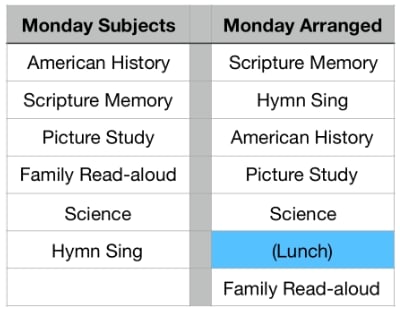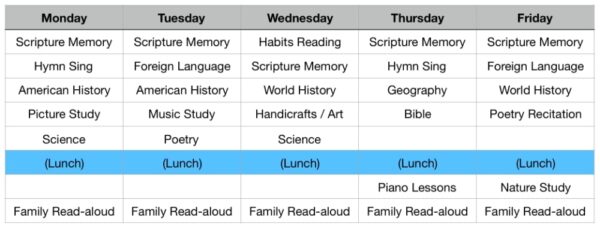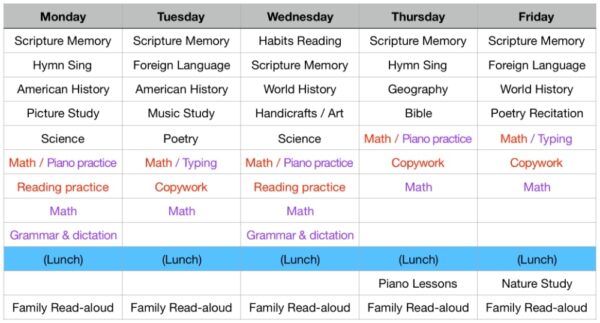60-day returns • free shipping on USA orders $129+
Planning for your home school can sometimes seem overwhelming. But let me encourage you that the more you do it, the easier it gets. And today I want to share with you a quick and simple trick I use when I’m trying to lay out a weekly schedule and a daily schedule.
I’ve been using this technique for more than ten years and shared it with hundreds of homeschooling mamas all over the world. It’s really quite simple, but that’s the beauty of it.
You’ll need a stack of index cards and a large flat space—it might be the dining room table or your bedroom floor. Here’s a tip: choose a low traffic area or do this during a time of the day when you won’t have to share that space with little hands and feet. If that’s next to impossible, you might use self-stick notes instead.
Now grab four or five cards and write on them the days of the week that you do your schooling. That might be Monday through Friday; write them one per card. Or if you homeschool four days per week, write those days—maybe Monday through Thursday or Tuesday through Friday or Monday, Wednesday, Friday, and Saturday. There are many ways to set up your schedule. Do what fits your family best.
Lay out those day cards in a row in order. For my example, I’m going to use a five-day week: Monday through Friday, so I lay out Monday, Tuesday, Wednesday, Thursday, Friday across in a row.


Next, think about any outside commitments that you have regularly. Perhaps you go to a co-op every Monday. If so, write “Co-op” on a card and lay it below Monday. Maybe you have piano lessons every Thursday or an occupational therapy session every Friday. Any regular weekly activities that occur outside the lessons in your home, write those on cards and lay them below the days on which they happen.
It helps to put outside activities in place first, so you can see those extra commitments as you arrange your home schedule. With outside commitments already in place, you can plan around them and make sure you’re not overloading those days and setting yourself (and your children) up for frustration and stress.
Don’t worry about when those activities occur during the day—morning or afternoon or evening. For now, just lay each one below the day on which it occurs. We’ll arrange each day later. For my example, I’m going to add piano lessons on Thursday.


Once you have those outside commitments in place . . . And by the way, this might be a good time to take a look at all of your outside activities and see how much is there. Is that a manageable load or is it starting to expand and beginning to encroach on the time you need for unhurried home lessons and good home care? Only you can answer that question for your family. But let me encourage you that if you look at those outside activities cards and wonder how you’re ever going to be able to do it all, don’t. Take steps now to simplify. Don’t set yourself up for chaotic, pressure-cooker days. Give yourself and your children margin in your schedule, and guard that margin. Rest is just as important as action.
All right, enough on that rabbit trail. Once you have those outside commitments in place, you can start adding in your school subjects. Take each subject one at a time, determine how many days per week you need to do that subject, and write it on that many cards. If you’re going to be doing American History two days per week and World History two days per week, write “American History” on two cards and “World History” on two cards. If you want to do Scripture Memory every day, write it on five cards. Picture Study is usually done once a week, as are Nature Study, Music Study, and Handicrafts or Art Instruction.
If you’re not sure how many days per week you need to do a subject, let me refer you to the post called 5 Steps to Planning Your Charlotte Mason Education. In that post, I break down planning into five simple steps, starting with the big picture, then gradually narrowing the focus to your year, your term, your week, and your day. When I talk about your term and your week, I explain how to figure out how many days per week you will need to cover a subject. So check out that part of that post if you need a refresher.
Once you get the subjects written on the number of cards that you need, all you have to do is select which days of the week you want to do them.
I’m doing American History on two days per week, so I’ll pop those two cards onto Monday and Tuesday.


I’m doing World History on two days, so I’ll put one on Wednesday . . . and then I have a decision to make. I have piano lessons already on Thursday, so I know I want to keep that day relatively light so as not to overload it. I think I’ll put the other World History on Friday.


I want to do Scripture Memory every day. Since Thursday is a lighter day, I’ll put Geography there. And I have the four once-a-week subjects that I mentioned. I can spread those out, one per day. And so on. You get the idea.


Just keep spreading your Subject cards out over the days of the week, so you can see what the workload will be like and make sure you’re not overloading one day and doing next to nothing on another day.


The subjects that I have laid out so far are the ones that you can do all together as a family. The Simply Charlotte Mason curriculum is set up to work this way. The only subjects that need to be done individually are math and language arts and the upper level sciences. If your curriculum has each student on his or her own separate track for every subject, you’ll need to arrange a separate set of cards for each student. But with Family-together curriculum, we can do one layout for all of the Family subjects. I’ll show you how to add in the Individual subjects of math and language arts in just a minute.
Once you have your Family work distributed across the days of the week the way you want them, then go back and focus on each day, one at a time. So let’s look at Monday’s subject line up: American History, Scripture Memory, Picture Study, Family Read-aloud, Science, and Hymn Singing. What we want to do is arrange Monday’s cards in a way that will alternate intense subjects with less intense subjects.
By arranging your daily schedule to use different parts of the brain as you go through the sequence, you make it easier for your children to pay full attention. What you don’t want to do is put two read-and-narrate subjects back to back; that will overwork and tire out the read-and-narrate part of the brain. The more tired the brain gets, the harder it is to pay full attention. So make sure you put other less intense subjects in between the read-and-narrate subjects. Use a different part of the brain.
On Monday we might start with Scripture Memory, then sing our hymn. After that we can read and narrate history, but then use a different part of the brain and do picture study—looking at art and discussing it. After that we can do another read-and-narrate with our science book. The Family Read-aloud is another subject with reading from a book, so we don’t want to do that back-to-back right after science. But we usually do our Family read-aloud later in the day anyway, during snack time in the afternoon. So we can leave it there and know that there’s a nice break in between those two subjects.


Then do the same thing with your Tuesday cards: arrange them in an order that uses different parts of the brain as you work through the day. You can do that with all of your remaining days. The cards just help make it quick and simple to play with different arrangements in order to find the one that will work best for your week and for each day.


Now let’s add the Individual subjects: math and language arts for each child. An easy way to add the Individual subjects is to color code those cards. Let’s say, Joey is in second grade and his math and language arts will be red; Suzy is in fourth grade and her individual subjects will be purple. You could use red and purple felt-tip markers to write the subjects on the cards or just put a little color squiggle somewhere on the card or get a pack of different colored cards—whatever you’d like to do. Then tuck those subjects into each day as it will work best for your family, keeping in mind that principle of sequencing the subjects to use different parts of the brain as you go through the day.


This little exercise will also help you see when you will be working with one student and need to figure out what the other student could be doing on her own. For example, I can have Suzy practice piano or do typing practice while I’m working with Joey on his math and language arts. If you need some ideas for good independent work—that’s not busywork—check out the post called 40 Ideas for Independent Work.
So that’s how the Subject cards work. Using cards to arrange your week and your days gives you a great visual picture of what’s going on and a lot of flexibility to move things around as you go through the process.
Once you get the cards arranged the way you like them, take a picture of that schedule and you’ll be good to go. You can copy it onto a sheet of paper or type it into a spreadsheet if you want to. Then post it where everyone can see the schedule. Hang onto your cards; keep them in a safe place, and you’ll have a handy tool at your fingertips when you’re ready to change your schedule.
We have a set of Subject cards that you can download free on our website. There will be several cards for each subject, but that doesn’t mean you have to use all of them. You decide how many of each you want to use. And there will be some empty cards included that you can use for special subjects, independent work ideas, and those outside commitments that all have a place in your schedule.
I hope this idea and the free set of cards will make it a little easier and a little simpler to lay out your weekly and daily homeschool schedule.
Podcast: Play in new window | Download
Podcast (podcastv): Play in new window | Download

How would this work for 6 students from kindergarten through 10th grade?
Hi Sarah,
You will still complete the process in the same way as laid out in the post. Due to having 6 children in the mix I would print out extra sets of the subject cards to play around with. Our blog post How To Finish Lessons By Lunch gives an example of a family with 5 children in grades 2-10. It may be a great spring board of ideas for you.https://simplycharlottemason.com/blog/how-to-finish-lessons-by-lunch/